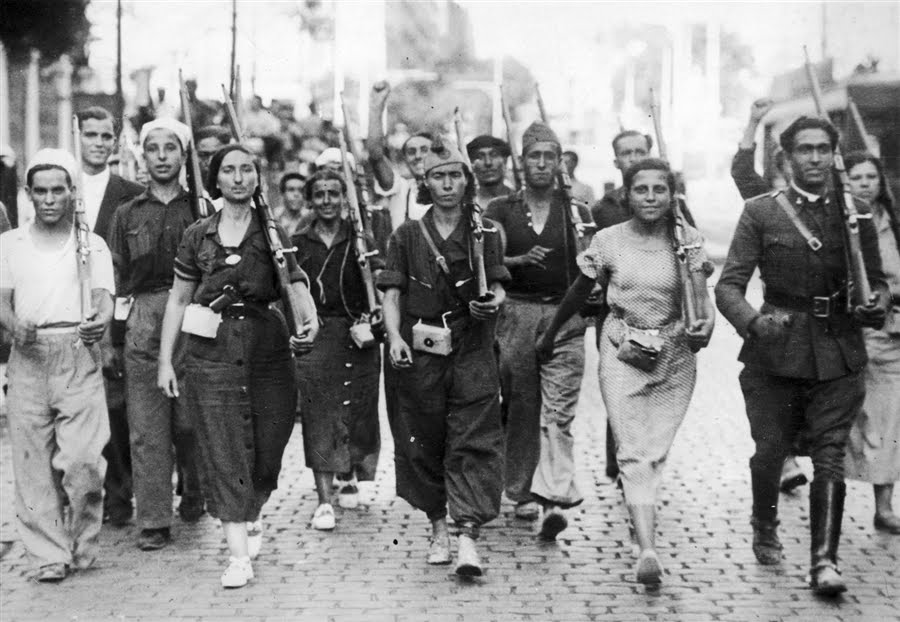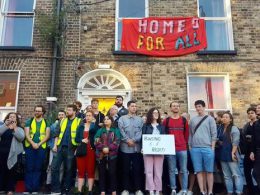“A defeat snatched from the jaws of victory” is the simplest way to describe the Spanish Revolution. The workers and peasants of Spain, together with thousands of socialist volunteers from around the world, displayed a matchless revolutionary spirit in their struggle against fascism. In July 1936, bankers and captains of industry across the world trembled at the thought of a new October Revolution, in which the Russian working class seized power and established the world’s first workers’ state in 1917. The masses in Spain moved in this direction as armed workers took control of the streets, set up political committees, destroyed the army, and seized the factories and the land.
The Russian revolutionary leader, Leon Trotsky, noted that the spontaneous revolutionary action of the working class in Spain had carried them to an even higher level than that of the Russian Revolution in its first stages.1 Tragically, this movement was crushed by capitalism in its fascist variant, mainly as a result of the reformist ideas and practices of the leadership of every workers’ organisation in Spain.
In the 80 years since the Spanish civil war began, the bankruptcy of reformist ideas for the workers’ movement has been demonstrated time and again. Millions around the world were inspired by the 61% Oxi (No) vote by the Greek people in the referendum on the austerity memorandum in 2015. Working class people stood firm against all of the blackmail and threats from European imperialism and the Greek establishment, only to be sold-out within hours by the leadership of Syriza. This same party is now spearheading the destruction of wages and public services, while acting as the bulwark of Fortress Europe in the Mediterranean.
While the reformism of Syriza resided in the belief that the neo-liberal, authoritarian EU can be changed for the benefit of the working class, in Spain in 1936, all the leaders of the mass workers’ organisations subscribed to the idea that the main priority was to, “win the war first; systemic change can be won after that”.
A society ripe for revolution
Spain had one of the weakest economies in Europe in the 1930s, and was hit hard by the effects of the 1929 financial crash. Spain had once been the most powerful country in the world, but had lost all of its colonies in Latin America during the nineteenth century. Like Ireland in the early twentieth century, Spain was predominantly an agricultural country, where 70 percent of the active population worked on the land.2 And like Ireland, the Catholic Church was closely intertwined with the ruling class and the state. The Church was simultaneously the biggest capitalist and the biggest landowner,3 and so had a major interest in defending the status quo. There was a growing resentment to the Church in rural areas, particularly those with vast social inequality such as Andalusia where a handful of big landowners held sway and most of the population struggled to survive as day-labourers. In 1931 over 80 percent of women in Spain were illiterate4 and there were actually as many nuns and monks as secondary school students.5
The big landowners invested in industry, but industry as a whole in Spain was heavily dependent on foreign investment. Orwell noted that, “Foreign capital was heavily invested in Spain. The Barcelona Traction Company, for instance, represented ten millions of British capital.”6 International capitalism had direct economic as well as political interests in maintaining ‘stability’ in Spain.
There were also large workers’ organisations such as the anarchist CNT trade union and the Social Democratic UGT trade union – linked to the Socialist Party – which both had over a million members in 1935.7 The rise of the far-right monarchists and fascist Falange organisation in the 1930s prompted an increased combativeness from the Spanish working class which had witnessed the Nazis’ rise to power on the bones of the German working class.
The archaic and top heavy Spanish army had suffered successive defeats for over a century. They bore heavy losses waging a war against the Moroccan people in the 1920s, but had just about held on to Spanish rule there. There was one officer to every eleven soldiers, who were mainly the sons of landowners and the rich.8 The majority of officers supported the far-right and were resolutely opposed to land redistribution of any kind.
Under the cover of attempting to prevent a coalition of the far-right coming to power in January 1936, the main workers’ organisations including the Communist Party (CP), the Socialist Party and the POUM, signed the Popular Front pact with the Republican Party. The Popular Front won the election, but only the Republicans formed the government.
Like the Syriza government in 2015, this Popular Front government sat on its hands as the bosses went on a strike of capital and withdrew their wealth from Spanish banks and businesses. Spanish capitalists were outraged about this government’s proposed land reforms and funded the fascist para-military, Falange’s, campaign of violent attacks on left-wing activists and workers’ demonstrations. The forerunners of the Socialist Party argued at the time that the expropriation of the landowners and the redistribution of land to the rural poor, “was impossible under capitalism, because the whole structure of Spanish banking rests on the land mortgages, so that the ruin of the big landowners would mean the ruin of the capitalists and bankers.”9 This explains the outrage in response to the Popular Front’s proposal to gradually phase in a land reform programme which would not be completed for a further 248 years!10 The working class fought back against the attacks of the Right and the bosses with 133 local general strikes between Feb and July 1936.11
Officials in the government had information that the generals in the army were plotting a coup d’etat but refused to arrest them. The government refused to tackle these generals and their followers because they thought they could negotiate some sort of truce. They also feared that if the army rose up, there would be calls for the arming of the working class and poor.
The prime minister of the Republic, Casares Quiroga, was informed on 17 July that the generals in various parts of the country were planning a coup and had already launched an insurrection in Morocco. According to various witnesses his response was, “They’re rising? Very well, I shall go to bed.”12
Dual Power
Except for five divisions, the entire army went over to the fascist rebels led by Francisco Franco. Without concerning themselves with Popular Front preaching about legalities and parliamentary authority, working class people fraternised with the soldiers, disarmed them and emptied the arms depots in Madrid, Barcelona and Valencia.13
By 19 July the fascists swept through much of the rural south and parts of the north. In the major cities and most of Catalonia the authority of the Republican government had literally crumbled away. The government was still in existence, as no revolutionary authority had stepped forward as an avowed rival to it, but its authority didn’t extend far outside Madrid. At this point, its only means of communication with the other “republican” zones at this stage was with the help of the workers’ organisations such as the networks of the UGT. Marxist historian Pierre Broué describes that:
“Between the streets and the government there gradually emerged new organs of power… these were the countless local Committees, virtual governments on a regional scale… In them was invested the new power, the revolutionary power that was being organised at full speed to deal with the enormous tasks, one immediate and the other long-term, of pursuing the war and resuming production at the height of a social revolution.”14
These armed Committees organised local militias to protect towns and cities and fight the fascists at the front. Unlike the fascist army, women fought for the militias and were involved at all Committee levels. Women launched poster campaigns against the buying of sex by men15 and abortion rights were won as well at this time.16 As the Church hierarchy unanimously supported the fascist rebellion. Church buildings were emptied of their bells and chalices which were then melted down to be used for industrial or military purposes. The buildings were then used as garages, markets, and shelters. The nature and scale of working class resistance emboldened the fascist generals. Franco told a journalist in the News Chronicle that he was ready, if necessary, to “shoot half of Spain”.17 Colonel Barato stated to the correspondent of the Toronto Star: “When we have executed two million Marxists, we shall have restored order.”18
A world turned upside down
Seventy percent of industrial firms in Catalonia were taken under democratic workers’ control, whether the owners had fled or not.19 A uniformity of wages was implemented in most of these workplaces, but the lack of a centralised plan by the Committees led to major problems. Lack of credit was a major barrier as the banks remained in private hands. The Madrid government held the gold reserves and sabotaged the Committees in Catalonia by refusing to take the banks into democratic public ownership. The revolution was also hamstrung by the government’s refusal to enact a monopoly on foreign trade. Workers who took control of companies with considerable reserves of money could issue immediate pay increases to the workforce, but others floundered. There was a reduction of prices at first as the payment of dividends to shareholders was eliminated, which allowed for more of the wealth that was created to be invested back into production.
In the countryside there were widespread land seizures and collectivisation by poor farmers and rural labourers, but they lacked a centralised plan for rapid modernisation of technique with agricultural machinery and access to credit. Overall however, a fresh wind blew through the economy, particularly in Catalonia, as the workforce gained a new sense of initiative and energy. For the first time people were working for themselves as well as for everyone. Unfortunately, no organisation or party called for a workers’ government under the slogan of “all power to the Committees”. The formation of a workers’ government at this point would simply have had to formalise and anchor what already existed.
The entire capitalist class had fled to the side of Franco’s fascist army at this point. Only their political representatives remained to cautiously attempt to rebuild the capitalist state in Republican territory.
The main excuse the Republican government used for opposing the collectives was that they needed the help of France and Britain to defeat the fascists and their German and Italian allies. European capitalism reacted swiftly to the July revolution. The states of Britain, France, Germany, Italy and the USSR signed the Non-Intervention Agreement, which banned these powers from supplying arms to either side of the war. Of course, Hitler and Mussolini ignored this agreement and supplied the rebels with all types of weapons, planes and troops. Fascists also enjoyed full freedom of movement across the Portuguese border.
Stalinism in Spain
The Stalinist bureaucracy in the Soviet Union (USSR) feared the consequences of a fascist victory in Spain, which would give a boost to Nazi Germany’s goal of destroying the USSR and colonising its territory. This bureaucracy was carrying out a targeted campaign of terror against political dissent within its own borders, and had no intention of assisting the revolutionary movement of the Spanish workers. Lev Kopelev, expressed the hopes that the Spanish Revolution inspired in many genuine socialists in the Soviet Union, “Spain awakened our old ideals and dreams about international brotherhood. They awakened precisely at a time when shameless lies and unrestrained terror raged around us.”20 In marked contrast, the conservative bureaucracy’s outlook was directed towards trying to build an alliance with British and French imperialism against the Fascist powers by proving that it could fight the rebels while actually defending capitalist property relations in Republican Spain. The Stalinists in Spain became the strongest advocates of the policy of “win the war first, then fight for socialism.”
Stalin’s regime sold weapons to the Republican government and provided technical and political assistance with officers and generals from the USSR. But this help came with stipulations. Under the guise of attempting to build a stronger more disciplined force to defeat Franco’s army, the Stalinists demanded that the militias and Committees be dissolved, and replaced by a regular police force and army to protect the property of big business. Anarchist and socialist leaders, who had now joined the Popular Front government, criminally justified these measures as the price that had to be paid for Soviet weapons.
Of course, this was all carried out with the most revolutionary language. The CP even appointed political commissars to boost the morale of the rank and file. Broué notes that while the original, “Red Army’s political commissars had been the propagandists of revolution and socialism, these two words were banished from the vocabulary of the Spanish commissars, one of whose reasons for existing… was precisely to combat all those in the Army for whom instantaneous revolution was still as important a task as the war.”21
Many senior civil servants, police and army officers who had stayed loyal to the republic turned to the CP for its defence of law, order and property. The CP also had the respect of large sections of the working class flowing from the courageous conduct of the rank-and-file CP members. The militants of the International Brigades, won particular acclaim. Many had fled fascist Germany and Italy and saw themselves as fighters in the international workers’ revolution. The Madrid working class, with the help of Soviet weapons, defeated Franco’s vicious ground troops and aerial bombardments in November.
“Adelante” was the cry around the hillside
Genuine revolutionary methods were adopted by the International Brigades in the battle of Guadalajara in March 1937. Italian Communists dropped political leaflets from planes and used loudspeakers to call on Italian fascist troops to desert. They urged them to join the Republican ranks, and turn on their leaders, who were the enemies of the Italian and Spanish workers. The Communists “crawled through the woods and instead of grenades, flung their compatriots leaflets weighted with stones… the morale of the troops from the Italian legions began to sag: prisoners and deserters now harangued their comrades, telling them how they had been welcomed and calling on their friends to join them.”22
The fascist general, Mancini, grew anxious and withdrew his frontline troops. Communist tanks and troops went into the attack, “while loudspeakers broadcast the Italian Communist anthem Bandiera Rossa, interspersed with calls for fraternization and surrender.”23 Broué describes how these defeated fascist soldiers were treated after they were captured, “On 18 March these thousands of young men, brought up under the Fascist regime, saw their dreams of grandeur fade and give place to new feelings as their astonished eyes beheld the ‘Reds’, from whom they feared the worst, sharing their meager rations with them and saying, ‘Now we are going to talk to you, not in response to the aggression we have endured, but to show you our feelings of brotherhood toward the whole world.”24
This galvanised workers across the world, as it was their first act of revenge against the triumphs of Mussolini and Hitler. However, because of the blockade, the war, and the efforts of the government and Stalinist leadership to protect corporations and banks rather than expropriating the wealth that existed in Republican Spain; inequality, poverty and the cost of living soared.
Red Barcelona
The new Republican police with the help of the GPU (the Soviet intelligence service), directed their attention to wiping out any activists who sought to promote revolutionary demands. The Revolution had gone further in Barcelona than anywhere else in July 1936. There was a widespread understanding here, that the Popular Front and Stalinists were destroying the revolution. Most workers across Catalonia supported either the anarchist CNT or the POUM. The POUM had lost a lot of credibility when it entered the government in September ‘36, but it was removed from its position at the insistence of the Stalinists in December. The POUM had 8,000 members in June ‘36 and had quadrupled its membership by May ‘37, as many workers rallied to its call for maintaining the militias and collectives that still existed in Catalonia.
On 3 May 1937, the police tried to take over the Barcelona Telephone Exchange, which was under anarchist control. In response to this state aggression, there was a spontaneous mass strike and insurrection of the entire working class across the city. The workers of Barcelona organised armed patrols and barricades, that no trade union of party had officially sanctioned.25 Once again, a clear situation of ‘dual power’ existed, as the working class and its Committees stood as a revolutionary alternative to the Republican government. Unlike the workers’ councils (soviets) formed during the Russian Revolution, however, the Committees formed in Spain were not elected bodies, with representatives who were subject to recall, and organised on a workplace, local, regional and national basis. They had been organised spontaneously, in July and May, but were everywhere dominated by leaders of existing organisations and parties and failed to change themselves into a direct expression of the insurgent masses.26 The POUM should have called for real, independent Committees, modeled on the soviets. On 4 May, the CNT Regional Committee issued a statement to the working class over the radio, “Lay down your arms. It is fascism we must destroy.” This was ignored by the workers. The POUM had the opportunity to take a decisive position of “All power to the Committees”, with an appeal to the international working class over the heads of the Popular Front, but they vacillated. Their leader, Andres Nin, argued that, “The moment was not favourable for a decisive action… it was necessary to provide limited slogans for the movement.”27 But this assessment of the situation does not hold up to scrutiny.
The workers held power in cities and towns across Catalonia, and had learned from the mistakes of 1936. The POUM orientated to other groups on the Left rather than harness the mood of the more militant working class. In Russia, in April 1917, most of the leadership of the Bolshevik Party argued that because they only had the support of a minority of the workers, they had to support the popular front of the Provisional Government, made up of a coalition of reformist and liberal capitalist parties. But Lenin won the rank-and-file Bolsheviks to a position of orientating to the revolutionary working class and patiently explaining the need for a workers’ government to overthrow capitalism. This position was borne out in October 1917.
Amidst the wavering of all of their political organisations, the working class of Barcelona dispersed. Six thousand extra police entered the city and Nin was arrested and murdered by the Stalinist GPU. By January 1938, there were 15,000 revolutionaries in prison in Republican Catalonia.28
The Republican army suffered defeat after defeat for the next year 18 months. In January 1939, the Communist Party sent a group of ‘commissars’ to Barcelona in a desperate attempt to organise the type of popular resistance that had saved Madrid in November 1937,29 but their slogan of “to the barricades! For the Red Front as on 19 July,” fell on deaf ears.30 The broader working class would not respond to the executioners of those who built the barricades of July ’36 and May ‘37.
Franco took Barcelona and declared victory on 26 January 1939.
Defeat snatched from the jaws of victory
The Republican army had an abundant supply of weapons, but it had destroyed the revolutionary aspirations that had fueled the victory of the largely unarmed workers in July 1936. At every juncture the bankruptcy of reformism was exposed. A significant proportion of Franco’s troops consisted of mercenaries from Morocco. A delegation of Moroccan nationalist leaders traveled to Barcelona in August 1936, pledging to fight for the revolution if they could get assurances relating to Moroccan independence.31 An official campaign of self-determination for Morocco could have pulled the rug from under Franco’s army. But as the Stalinists and anarchists didn’t want to offend Britain and France with their colonies in Algeria, Egypt and Palestine, they suppressed this option.
Stalin’s demands to dissolve the Committees and collectives in return for weapons could have been dismissed by the workers’ organisations. The industrial factories which were already under workers’ control could have been converted to produce arms. The workers’ leaders chose instead to depend on Moscow. In any case, technical and strategic problems weren’t as decisive as political mistakes. In his criticism of the Spanish Left, Trotsky pointed to the American Civil War as an example of how politics always dominates over strategy in civil wars, “Robert Lee, as an army chieftain, was surely more talented than Grant, but the programme of the liquidation of slavery assured victory to Grant.”32
Had the POUM, or any genuine revolutionary organisation, been willing to mobilise and lead the Catalan working class to seize power in May ‘37, as it had already seized power in July ‘36, they would have found support throughout Spain. The workers and poor in areas occupied by Franco could have looked to Catalonia and found the initiative to smash the fascists. Trotsky argued that under these conditions, no “foreign government would have risked throwing its regiments onto the burning soil of Spain. Intervention would have become materially impossible, or at least extremely dangerous.”33
Unlike the POUM, international capitalism had not forgotten the lessons of the Russian Revolution at this time. A revolutionary Spain would have inspired a historically unprecedented movement for socialism across Europe, North Africa, the Soviet Union, and beyond. Instead, the organisations of the Spanish Left looked to the bankers of Britain and France and their ‘democratic’ representatives for salvation. The result was the elimination of all the political and industrial organisations of the Spanish working class, and the systematic murder of up to 200,000 people after the war.34 The victory of Franco also galvanised the other fascist states to upscale their plans for imperialist expansion, and tens of millions more would tragically die as a result.
Anyone who believes that a better world is possible should reflect on the inspiring examples and hard lessons of the Spanish Revolution.
Notes
1 Pierre Broué, 1967, Trotsky and the Spanish Revolution, Fourth International, Vol 4 no. 1, p. 12
2 Pierre Broué & Emile Témime, 1972, The Revolution and the Civil War in Spain, Faber & Faber, p. 32
3 Ted Grant, 1973, The Spanish Revolution 1931-37. Ted Grant and Peter Taaffe, Militant Publications, 1985, p. 26
4 Cinzia Arruzza, 2013, Dangerous Liaisons: The marriages and divorces of Marxism and Feminism, Merlin Press, p. 44
5 Leon Trotsky, 1931, “The revolution in Spain”. In The Spanish Revolution: 1931-39, Pathfinder Press. Edited by Naomi Allen and George Breitman, 1973, p. 79
6 George Orwell, 2000, Homage to Catalonia, Penguin Books, p. 201
7 Pierre Broué & Emile Témime, 1972, Faber & Faber, p. 67
8 The Spanish Civil War: Prelude to Tragedy, Granada Television, UK. 1983
9 Ralph Lee & Ted Grant, 1938, Lessons of Spain
10 Jean Rous, 1939, Spain 1936-39: The Murdered Revolution (Part 2), <www.marxists.org/history/etol/revhist/backiss/vol4/no1-2/rous.htm Accessed on 26/06/2016>
11 Peter Taaffe, 2006, Storming Heaven
12 Pierre Broué & Emile Témime, 1972, Faber & Faber, p. 97
13 Jean Rous, 1939, Spain 1936-39: The Murdered Revolution (Part 1)
14 Pierre Broué & Emile Témime, 1972, Faber & Faber, p. 121
15 George Orwell, 2000, Homage to Catalonia, Penguin Books, p. 99 l 16 Cinzia Arruzza, 2013, Merlin Press, p. 44
17 Pierre Broué & Emile Témime, 1972, Faber & Faber, p. 184
18 Ibid, p. 184 l 19 Ibid, p. 152
20 Vadim Z. Rogovin, 1937: Stalin’s Year of Terror, Mehring Books, p. 336
21 Pierre Broué and Emile Témime , 1972, Faber & Faber, p. 234
22 Ibid, p. 259
23 Ibid, p. 259
24 Ibid, p. 260
25 Pierre Broué & Emile Témime, 1972, Faber & Faber, p. 283
26 Ibid, p. 189
27 Pierre Broué, 1988, The ‘May Days’ of 1937 in Barcelona l 28 Jean Rous, 1939, (Part 2)
29 Paul Preston, 2014, The Last Stalinist: The life of Santiago Carrillo, William Collins, p. 96
30 Jean Rous, 1939, (Part2)
31 Ibid l 32 Leon Trotsky, 1937, “Interview with Havas”. In The Spanish Revolution: 1931-39, p. 297
33 L Trotsky, 1937, A test of ideas and individuals through the Spanish experience, The Spanish Revolution 1931–1939, p. 342
34 Hannah Sell, 2009, The Spanish Civil War












